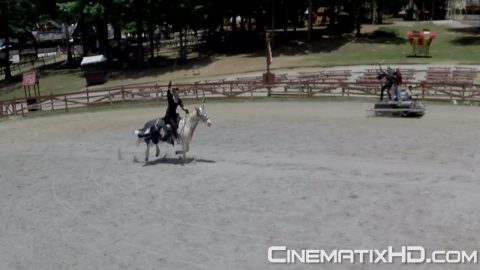In this first of our Pro-Tip series Cinematographer Jim Ross shows you step by step how to set up a professional circular dolly track just like for a Hollywood movie or professional TV commercial.
Using equipment from PC&E in Atlanta Georgia, Jim sets up track from American Grip, utilizes a Doorway Dolly, and uses specialized Porta-glide wheels for curved track. He even demonstrates how to level the track using Mathews Grip Equipment Apple boxes.
TRANSCRIPT: First things first. You’ll need a truck. And a crew. A circular dolly setup takes eight pieces of curved track and it’s pretty big. So get some help. And wear gloves. Typically the rails will be pretty filthy, and anytime you are working with metal there is a chance of getting cut by a sharp edge.
First we’re going to lay the track out roughly where we want to use it. If you are circling a product or set remember that you can’t drive over the track so have the product inside the circle like we do here. I’m choosing where to lay the rails based upon the best spot for the track, and not worrying about the mower. I knew I could move the mover. Once you get the track roughly laid out you can start locking it together. It’s fairly simple and may remind you of your model train you had when you were a kid.
Once the ends are flush you can snap the locks to secure the track. We’re laying out boards both to protect the lawn, and to make a flat surface. Once you have assembled the track its time to start leveling it. Using my eye and reflecting on my experience doing this before I can gauge how much we are going to have to level the track. If the surface is very flat you can get away with wedges and cribbing. Not so here, so we’ve gotten a good supply of apple boxes as well. First we flush out a rough level with the boxes. When you see low spots you build them up with apple boxes.
For smaller spaces use blocks and use the wedges to build height in increments. In places you’ll use all three. Then, I use use two techniques to fine tune the level. I use an actual bubble level to test if the rails are level, and I use the Portaglide wheels themselves to make sure there are no low spots. Literally you let gravity do the work to fine tune your track. As you can see it’s very much trial and error. And you’ll find as you fix one part you might create a problem elsewhere. So you will be going back and forth quite a bit. However, the success of your shot depends upon the track being level. Otherwise the camera angle will rise and fall even though the track ride seems very smooth.
How much support your track requires depends on what you are using to film. If you are using a cinema dolly like a fisher or chapman and you will need to support hundreds if not thousands of pounds so you’ll need to support every one of the cross ties on each side. Here we are only using a doorway dolly supporting just the camera. So we can get away with less support to save time. Once I’m happy with the track I’ll add the dolly. Because the added weight will affect the level of the track you will find yourself fine tuning the track yet again. Here you can see Chris tapping the track to see if there is space under the track tie. This will result in a dip when the dolly rolls so he then fills the spot with a wedge. Meanwhile I continue to look for places that need adjustment, using the added weight of the doorway dolly to flush out soft spots. And it’s a good excuse to go back to being a kid again and go for a ride on my very own man sized train set.
A circular dolly shot is great for products that you want to show in 360. As with most production equipment it’s best to rent than to buy. We picked up our setup at PC&E in Atlanta. Our setup today would cost over 12 grand if we bought it. Instead we rent it only when we need it for a fraction of that. I hope you enjoyed this HDPros tip on setting up a circular dolly track. I’m cinematographer Jim Ross with CinematixHD in Atlanta. Thanks for watching and we’ll see you next time.
www.HDPros.net www.cinematixhd.com 770-938-7077










